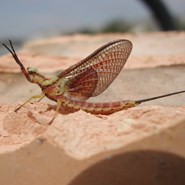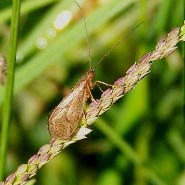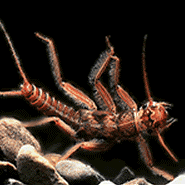|
Insects and other macroinvertebrates serve as indicators of the health of our rivers and streams. How does this work? Certain organisms require high levels of dissolved oxygen (found in clean, healthy streams) to survive, and others thrive in lower levels of dissolved oxygen (found in more polluted streams). So, by looking at the insects surviving in the ecosystem, we can determine the relative oxygen levels, and therefore the health of the system. It is partially for this reason that insects are so important to the Indian River ecosystem in Sitka National Historical Park. This river depends upon the dynamic cycle of nutrients and energy being carried through its waters, and insects play a vital role in that process. Healthy streams especially have a diverse complement of mayflies, stoneflies, and caddisflies. Read further on below to learn about the main insects found in Indian River and the role they play in the health of our waterways!
The ecological role of aquatic insects depends on their feeding behavior. These behaviors have been categorized as Functional Feeding Groups. Four groups are important in the Indian River.

NPS Photo / Blake Trester Mayflies are short-lived insects that thrive in the Indian River, which runs through Sitka National Historical Park. How short-lived are these species? They will go through a naiad (nymph) stage for about a year in freshwater before becoming a winged adult that lives anywhere from a few minutes to a few days! While most species feed on algae, some are predatory, feeding on smaller prey organisms. Mayflies are categorized in several different ways, most starting with their method of locomotion. The main movement types of mayflies are swimmers, clingers, and sprawlers. Swimmers are characterized by their tendency to cling to the surfaces of rocks in between bouts of swimming from one rock to another. Families in this category include Small Minnow Mayflies (family baetidae), Prong-gilled Mayflies (family leptophlebiidae); and Combmouthed Minnow Mayflies (family ameletidae)
Clingers are less keen on traveling and will attach themselves to surfaces with suckers, claws, or silk. One of the local clinger families is the Flatheaded Mayflies (family heptageniidae), which are good indicators of water quality, as the larvae are intolerant of nutrient pollution in the water
Sprawlers live in the surfaces of floating leaves or sediments, and must keep their gills free of silt. Spiny-crawler Mayflies (family ephemerillidae) are one of the families in the sprawler category that lives in Indian River. They are known to use their spiny tails in defense when threatened, by raising them up, or curling them under their abdomen so the tail projects in front of the head.

USFWS / Public Domain Caddisflies produce silk, and are divided into 3 different behavioral groups based on how they use their silk: free-livers, net-makers, and case-makers. The latter two (net-making and case-making caddisflies) will enlarge their silk structures throughout their larval lifespan, while those in the free-living group do not create a case until they are ready to pupate. Net-makers usually live in running water. Their nets are used to collect algae and detritus, as well as used for shelter. Free-living caddisflies are known to be the most primitive of the caddisflies, with fossil evidence dating back to the Jurrasic period. As these caddisflies do not depend on nets or casings for protection or food collection, they are predatory, feeding on smaller prey organisms during their larval stage. 
NPS Photo Stoneflies (order Plecoptera) Stoneflies are excellent indicator species because of their extreme intolerance of water pollution; in other words, they only survive in streams with good water quality. They are either shredders of leaf litter or predators on other macroinvertebrates in Indian River, and some may scavenge on dead salmon. Below you will find a brief description of some of the stonefly species found in Indian River. Other Aquatic InsectsTrue Flies (Diptera) Filter-collectors. Larval blackflies have fans that they extend into the stream current. These fans can filter out particles as fine bacteria. Crane Flies (Tipulidae) Large shredders of leaf litter. Flatworms (Turbellaria) Predators and collector-gatherers. They are sometime found on dead salmon. Water Mites (Hydracarina) These are predators or parasites depending on life stage. Aquatic Earthworms (Oligochaeta) Collector-gatherers. |
Last updated: February 5, 2019
